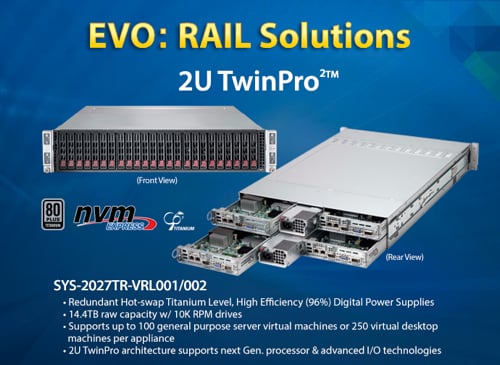This article is more than 1 year old
Is hyper-convergence a good thing? Ask a mini computer veteran
Divergence and convergence brings us back to the future?
Hyper-convergence wins
These proved attractive to customers, even though lock-in was present, and both suppliers attracted plenty of venture capital funding and grew quickly.
Competitors sprang up offering hyper-converged system software which channel partners could use with certified hardware to produce their own hyper-converged systems; think Maxta and ScaleIO.
Such software-driven hyper-convergence, with sets of certified hardware components reduced the hardware lock-in disadvantage, although not the software one.
Nutanix and SimpliVity promptly unbundled their software and offered it through OEMs such as Dell, which built the entire system itself, or in partnership with server suppliers such as Cisco, letting channel partners build the finished systems.
Part of the background here is that servers are getting virtualised and enterprises are increasingly running applications in virtual machines (VM). Pretty much a virtual machine is a virtual machine is a virtual machine, with the standardised virtual machine container helping to increase the commodification of computer systems.
The systems had to provide processing, storage and data networking for virtual machines. So why not treat the whole set of system components as a virtual machine-centric entity?
There was the obvious opportunity here for converged system building to be driven by standardisation onto widely used and available server virtualisation software. That would attract more hardware partners and reduce the lock-in element even more.
EVO:RAIL arrives
VMware then devised its EVO:RAIL hyper-converged architecture along these lines, featuring its vSphere hypervisor and Virtual SAN software, with multiple VMware partners building their own EVO:RAIL-compliant systems and delivering them as ready-to-run appliances.
The components are:
- Base unit of four nodes in a 2U rackmount enclosure
- A node consists of:
-
- Dual Xeon E5-2620 6-core processors
- 192GB memory
- 3 x 1.2TB 10,000rpm disk drives
- 400GB SSD
- ESXi boot device
- Two redundant power supplies
- Two redundant 10GbE Network Interface Cards
- 1.6TB of read/write caching SSD
- 14.4TB of disk drive storage
- Virtual SAN 13.1TB datastore
- vCenter Server and Log Insight
- Deployment, configuration and management software
Each node runs ESXi and the four-node base unit is a cluster, meaning that there is node redundancy and an individual node can be patched or upgraded without the cluster failing.
A base unit can run up to 100 general-purpose virtual machines or about 250 virtual desktops. There can be a cluster of up to four base units, meaning a 52.4TB Virtual SAN data store. This is a system geared to smaller enterprises and remote and branch offices.
VMware has also developed a higher-end offering called EVO:RACK, with more compute, storage and networking resources and scalability, which will be suited to larger IT shops.
The virtual SAN software aggregates the storage on separate nodes into a single virtual pool which can be used by all the nodes – a distributed SAN in a way.
This technology effectively absorbs the separate networked SAN array back into the system, reversing the original divergence between servers (minicomputers) and storage pioneered in the 1990s by products such as CLARiiON.
The fact that EMC bought Data General and its CLARiiON product line in 1999, and bought VMware as well thus paving the way to EVO:RAIL, provides a satisfying symmetry.
VMware says that the EVO:RAIL appliance is simple to manage, with no need for anything other than VMware admin skills.
The qualified VMware EVO:RAIL partner is responsible for all support, and the partner list includes global suppliers such as Dell, EMC, Fujitsu, HDS, HP, NetApp and SuperMicro, plus regional ones such as Net One Systems and Inspur in the Asia-Pacific region. Partners set their own prices and build the appliances using VMware’s EVO:RAIL cookbook.

Supermicro EVO:RAIL system
There is no physical Ethernet switch included in this cookbook and partners may elect to include one.
EMC has set up VSPEX Blue, a partner-built EVO:RAIL system. SuperMicro and Nexenta are building an EVO:RAIL system. Customer choices are multiplying.
An attractive aspect of EVO:RAIL's design is that you are not locked in to a single hardware supplier, although obviously VMware is paramount. As the main components are developed, with, for example, Cisco, Dell, or SuperMicro bringing out new servers, then the EVO:RAIL specifications will be updated to include them.
Target market
IT departments running lots of standard virtual machines, say from 100 to 400, or 250 to 1,000 virtual desktops, could buy EVO:RAIL appliance units to power them. This would be a lot easier to do than buying the separate components, paying for them to be integrated and then operating the resulting multi-supplier infrastructure.
Multiple EVO:RAIL clusters could be used where more virtual machines are needed. Each cluster would start small and grow appliance by appliance, with scaling needing a standard balance of compute, storage and networking resources.
If your application needs more than the average amount of any one of these items then EVO:RAIL is not for you. You need to be free to have more of, say, compute related to storage or storage related to compute (think Hadoop and big data) than EVO:RAIL’s standardised, middle-of-the-road, configurations can give you.
If your application scales up past 1,000 virtual machines then EVO:RAIL won’t cope with that. Bigger systems are needed, such as the coming EVO:RACK, Vblocks or ones built using more traditional multi-supplier component IT.
We are only at the start of hyper-converged systems and can expect generation two ones to scale much more, with perhaps a doubled cluster node count, larger storage capacity and so on.
Might we see a split into performance and capacity nodes? That is something for VMware’s development strategists to ponder. It is a step away from simplicity but equally, it is a step towards more flexibility. ®
